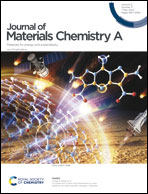Accurately simulating electrical double layers structure and formation using all-atom scaled-charge force fields†
Abstract
The electric double layers (EDLs) at the solid–liquid interface play a significant role in many applications such as batteries, supercapacitors, nano-friction, and capacitive deionization. Molecular dynamics (MD) simulations has become powerful tools for comprehending the microstructure of the EDLs, while their accuracy depends on employed force fields. Herein, we conducted constant potential-based MD simulations with distinct force fields to investigate the EDL structure and its formation. Results indicate that the all-atom force fields meticulously capture the transitions in the EDLs structure from overscreening to crowding. However, the crowding phenomenon is missed by the coarse-grained force field, attributed to its smaller ion volume leading to an underestimation of ion packing. Benefiting from their accuracy in dynamics, force fields that approximately consider polarization effects can precisely predict the charging process of the EDLs. Therefore, we conclude that the all-atom scaled-charge force field is the optimal choice for simulating the structure and formation of the EDLs. This work offers crucial insights into selecting the appropriate force field for future classical MD simulations.



 Please wait while we load your content...
Please wait while we load your content...